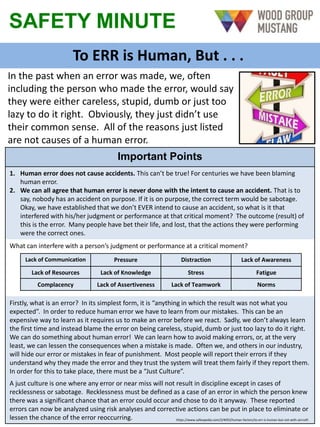
To ERR is Human, But . . .
- 1. SAFETY MINUTE To ERR is Human, But . . . In the past when an error was made, we, often including the person who made the error, would say they were either careless, stupid, dumb or just too lazy to do it right. Obviously, they just didn’t use their common sense. All of the reasons just listed are not causes of a human error. Important Points 1. Human error does not cause accidents. This can’t be true! For centuries we have been blaming human error. 2. We can all agree that human error is never done with the intent to cause an accident. That is to say, nobody has an accident on purpose. If it is on purpose, the correct term would be sabotage. Okay, we have established that we don’t EVER intend to cause an accident, so what is it that interfered with his/her judgment or performance at that critical moment? The outcome (result) of this is the error. Many people have bet their life, and lost, that the actions they were performing were the correct ones. What can interfere with a person’s judgment or performance at a critical moment? Firstly, what is an error? In its simplest form, it is “anything in which the result was not what you expected”. In order to reduce human error we have to learn from our mistakes. This can be an expensive way to learn as it requires us to make an error before we react. Sadly, we don’t always learn the first time and instead blame the error on being careless, stupid, dumb or just too lazy to do it right. We can do something about human error! We can learn how to avoid making errors, or, at the very least, we can lessen the consequences when a mistake is made. Often we, and others in our industry, will hide our error or mistakes in fear of punishment. Most people will report their errors if they understand why they made the error and they trust the system will treat them fairly if they report them. In order for this to take place, there must be a “Just Culture”. A just culture is one where any error or near miss will not result in discipline except in cases of recklessness or sabotage. Recklessness must be defined as a case of an error in which the person knew there was a significant chance that an error could occur and chose to do it anyway. These reported errors can now be analyzed using risk analyses and corrective actions can be put in place to eliminate or lessen the chance of the error reoccurring. Lack of Communication Pressure Distraction Lack of Awareness Lack of Resources Lack of Knowledge Stress Fatigue Complacency Lack of Assertiveness Lack of Teamwork Norms https://www.safeopedia.com/2/4055/human-factors/to-err-is-human-but-not-with-aircraft